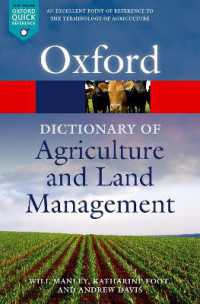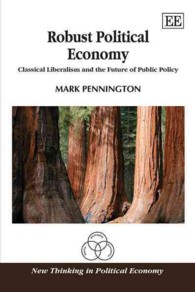- ホーム
- > 洋書
- > 英文書
- > Nature / Ecology
Full Description
This specially curated collection features four reviews of current and key research on improving crop nutrient use efficiency.
The first chapter explores the relationship between rhizobacteria and plant roots, looking primarily at the recruitment of rhizobacteria by the plant to carry out particular functions, such as nutrient acquisition. The chapter highlights our current understanding of the molecular determinants of legume nodulation as well as challenges for improvements of biological nitrogen fixation in legumes and non-legumes.
The second chapter considers the rising use of nitrogen (N) fertilizer in agriculture and its role in the shrinking contribution of soil organic N. The chapter explores the impact of the inefficient management of N (low nitrogen-use efficiency) and the consequent developments of major environmental issues, such as pollution to groundwater, oceans and the atmosphere.
The third chapter addresses key issues in using N fertilizers in wheat production, such as product cost and environmental impact. The chapter summarises the development of N-efficient cultivars and their economic benefits, as well as their role in reducing the environmental impact of excessive N fertilizer inputs, whilst maintaining respectable yields.
The final chapter considers the use of breeding techniques, including genetic variability, to develop more efficient wheat varieties with improved traits related to nitrogen capture, nitrogen assimilation and nitrogen remobilization.
Contents
Chapter 1 - Understanding plant-root interactions with rhizobacteria to improve biological nitrogen fixation in crops: Ulrike Mathesius, Australian National University, Australia; Jian Jin, La Trobe University, Australia and Chinese Academy of Sciences, China; Yansheng Li, Chinese Academy of Sciences, China; and Michelle Watt, Forschungszentrum Juelich GmbH, Germany and University of Melbourne, Australia; 1 Introduction2 Understanding existing interactions of plants with nitrogen-fixing rhizobacteria3 Improvements and limitations to nitrogen-fixing associations and engineering new symbioses4 Conclusion5 Acknowledgements6 Where to look for further information7 References
Chapter 2 - Advances in optimising nitrogen-use efficiency in crop production: J. F. Angus, CSIRO Agriculture and Food and Graham Centre - Charles Sturt University, Australia; 1 Introduction2 Some definitions of nitrogen-use efficiency3 Nitrogen demand and supply4 Practices to increase nitrogen-use efficiency5 Nitrogen overuse6 Conclusion7 Acknowledgement8 Where to look for further information9 References
Chapter 3 - Advances in understanding uptake and utilization of nitrogen in wheat: Ajit S. Nehe and M. John Foulkes, University of Nottingham, UK; 1 Introduction2 Forms of plant-available nitrogen and the role of nitrogen3 Definitions of nitrogen-use efficiency and its components4 Agronomic improvement of nitrogen-use efficiency5 Genetic trends in relation to nitrogen-use efficiency6 Physiological traits for improving nitrogen-use efficiency7 High-throughput phenotyping for nitrogen-use efficiency8 Conclusion9 Where to look for further information10 References
Chapter 4 - Improving the uptake and assimilation of nitrogen in wheat plants: Jacques Le Gouis, INRA, France and Malcolm Hawkesford, Rothamsted Research, UK; 1 Introduction2 Nitrogen uptake3 Nitrogen assimilation4 Nitrogen remobilization5 Future trends in research6 Where to look for further information7 Acknowledgements8 References







